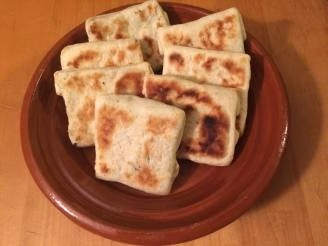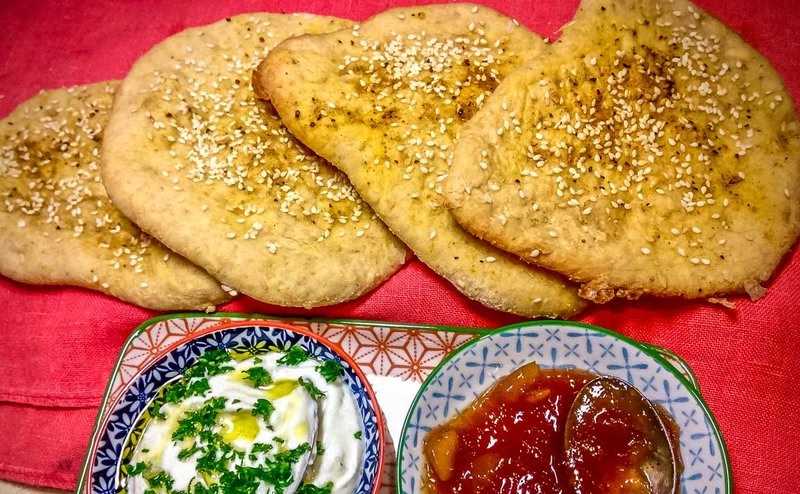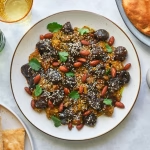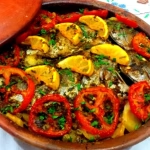
If you’ve ever wandered through a bustling Moroccan market, the aroma of warm bread and seasoned olives might have caught your attention. Moroccan Flatbread With Olives is not just a dish; it’s a celebration of flavors, textures, and tradition. This delightful flatbread, also known as khobz, has become a staple in Moroccan households and is loved for its versatility and rich taste.
The origins of this flatbread date back centuries, where it was traditionally baked in clay ovens known as taboon. The unique combination of fluffy bread and salty olives creates a mouthwatering treat that pairs beautifully with tagines, stews, or simply enjoyed on its own. In this article, you’ll learn how to make Moroccan Flatbread With Olives at home, explore variations, and even discover some pro tips to elevate your baking game. Ready to dive into the world of Moroccan culinary delights? Let’s get started!
Ingredients
| Ingredient | Measurement | Description |
|---|---|---|
| All-purpose flour | 3 cups | All-purpose flour serves as the foundation of your Moroccan flatbread, providing the perfect texture. |
| Warm water | 1 cup | Warm water activates the yeast, allowing the flatbread to rise properly and become fluffy. |
| Active dry yeast | 1 packet (2 1/4 tsp) | Yeast is essential for leavening, creating the bubbles that give Moroccan flatbread its lightness. |
| Olive oil | 2 tbsp | Olive oil adds richness and moisture, enhancing the overall flavor of the bread. |
| Salt | 1 tsp | Salt is not just for taste; it strengthens the dough and helps with fermentation. |
| Black olives | 1 cup (chopped) | Chopped black olives add a savory punch and give the flatbread its signature flavor. |
Step-by-Step Instructions
- Step 1: Prepare the Dough – In a large mixing bowl, combine the warm water and yeast. Let it stand for about 10 minutes until foamy, which means the yeast is alive and ready. Then, add the olive oil, salt, and flour gradually, mixing until a sticky dough forms.
- Step 2: Kneading the Dough – Transfer the dough onto a floured surface and knead it for about 8-10 minutes. This step develops the gluten, making your Moroccan flatbread chewy and delicious. If the dough is too sticky, sprinkle a bit more flour as needed.
- Step 3: First Rise – Place the kneaded dough in a lightly oiled bowl, cover it with a clean towel, and let it rise in a warm place for about 1 hour or until it doubles in size. This is crucial for a light and airy flatbread.
- Step 4: Incorporate the Olives – After the first rise, punch down the dough to release air. Gently fold in the chopped black olives until evenly distributed. This step adds a delightful burst of flavor in every bite.
- Step 5: Shape and Second Rise – Divide the dough into equal portions (about 4). Shape each piece into a ball and flatten it to about 1/2 inch thick. Cover with a towel and let them rise for another 30 minutes.
- Step 6: Bake the Flatbreads – Preheat your oven to 450°F (230°C). Place the flattened dough onto a baking sheet and bake for 10-12 minutes until golden brown. You can also cook it on a hot skillet for a more traditional touch.
- Step 7: Serve and Enjoy – Remove the Moroccan flatbread with olives from the oven, let it cool slightly, and serve warm with a drizzle of olive oil or your favorite dipping sauce. Enjoy the rich, savory flavors!
Pro Tips
- For a more authentic taste, consider adding spices like cumin or coriander to your dough mixture.
- If you like a crispy crust, place a pan of water in the oven while baking to create steam.
- Experiment with different types of olives, such as green or kalamata, for unique flavor profiles.
- If you’re preparing this ahead of time, the flatbread can be stored in the freezer. Just reheat in a warm oven before serving.
- Pair your fresh Moroccan flatbread with a side of *zhough* (spicy herb sauce) for a flavorful kick.
Nutritional Information
| Nutrient | Per Serving |
|---|---|
| Calories | 210 |
| Protein | 5g |
| Carbohydrates | 32g |
| Saturated Fats | 1g |
| Fiber | 2g |
| Cholesterol | 0mg |
| Sugars | 0g |
| Fat | 5g |
FAQs
What is the best way to store Moroccan Flatbread With Olives?
You can store the flatbread in an airtight container at room temperature for up to 3 days. For longer storage, wrap tightly in plastic and freeze.
Can Moroccan Flatbread With Olives be made vegan or gluten-free?
Absolutely! Substitute the all-purpose flour with a gluten-free blend and ensure your yeast is gluten-free. For a vegan option, just skip any egg wash.
What are the best side dishes to serve with Moroccan Flatbread With Olives?
Moroccan flatbread pairs excellently with tagines, salads, or dips like hummus and baba ganoush.
How long does it take to prepare Moroccan Flatbread With Olives?
The overall time, including rising, is about 2 hours. But the actual hands-on time is only about 30 minutes!
Can I freeze Moroccan Flatbread With Olives for later?
Yes, you can freeze the flatbread after it cools. Just reheat it in the oven or a skillet before serving.
Now that you’ve learned how to make Moroccan Flatbread With Olives, you can bring a taste of Morocco right into your kitchen. With its unique flavors and comforting texture, this flatbread is sure to impress your family and friends. Don’t forget to experiment with different variations and dipping sauces to make this recipe your own!
So, what are you waiting for? Try making this delicious Moroccan flatbread today and let us know your experience in the comments!





